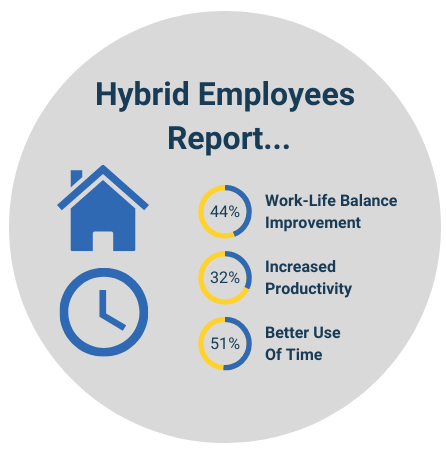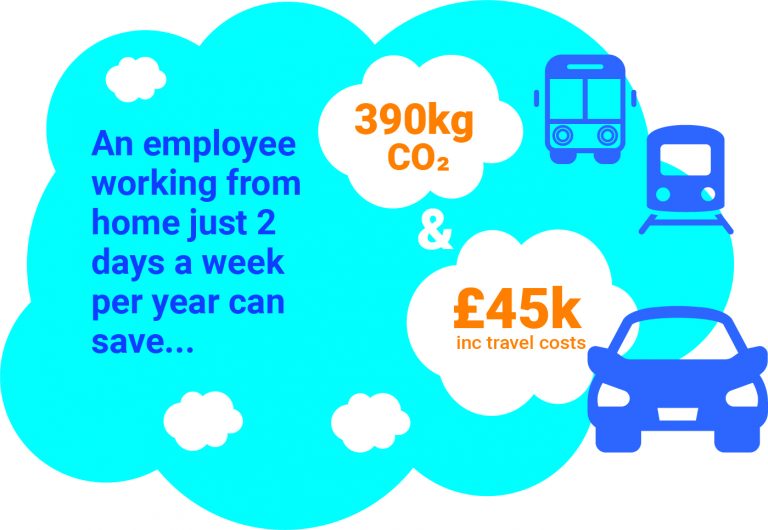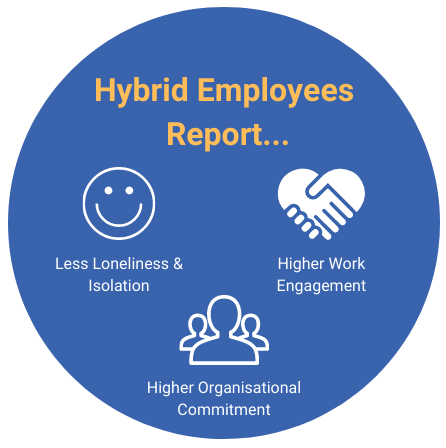What is Hybrid Working?
Hybrid working is a way of working involving both working remotely and in an office. A hybrid work culture allows employees to have the flexibility to work from home or any location outside of the office. However, employees can communicate and collaborate with their colleagues in person if needed.
For Employers, hybrid work models present opportunities to reduce office space and corporate real estate costs. Office space will still remain. However, a hybrid workplace will shift to smaller, high-quality collaborative offices. The office environment will change from single workstations and private offices to a place where employees collaborate and socialize.
Hybrid Work Model VS Flexible Working: What's the Difference?
In short, there is little difference. On the UK Government Website, they define flexible working as:
“A way of working that suits an employee’s needs, for example, having flexible start and finish times, or working from home.”
You can see that this is virtually identical to the hybrid work model definition. It wasn’t always the case, though. Before COVID-19, flexible working referred to flexible start and finish times; it seems only now has it started to include flexibility in where people work.
The Benefits of Hybrid Working
The hybrid work model can positively impact employees’ productivity and well-being. Here are just a few of the many hybrid work advantages.
1. Increased Productivity
When employees have the flexibility to work where they like, they can create a work environment that suits their needs. In addition, doing so can lead to fewer distractions and interruptions, allowing them to focus on their tasks.
Also, the hybrid model allows employees to work outside regular business hours, benefiting those with busy lives. Employees can then work when they are most productive and avoid office distractions.

2. Improved work-life balance
Employees can create a better work-life balance by working remotely. For example, Working from home reduces commute time and stress, leaving more time for family and hobbies. Reduced levels of stress and increased leisure time all impact a person’s mental health.
In addition, the hybrid working model gives employees control and reduces stress from juggling work and family, which can improve mental health.
3. Reduced costs and environmental impact
Hybrid work can provide significant cost savings and environmental benefits for organizations. For example, remote work can reduce the need for physical office space and related costs, such as utilities and maintenance.
Furthermore, hybrid work can also help to reduce the environmental impact of commuting. Not only can organizations save money, but they also help to support sustainability efforts and reduce their carbon footprint.

4. Improved employee retention and recruitment
With the flexibility and work-life balance it offers, hybrid work can be a big incentive for employees. In fact, employees expect freedom and flexibility in their working life.
Furthermore, location no longer limits the pool of potential employees. With the rise of remote work and the ability to work from anywhere, businesses can recruit from anywhere.
Hybrid work models can give organizations a competitive edge, leading to improved performance and success.
5. Employee Satisfaction
Hybrid work models are also associated with increases in job satisfaction. For example, remote workers are more likely to find their job pleasurable and stimulating.
In addition, higher job satisfaction among hybrid workers stems from their increased control over when and where they work.

Challenges of Hybrid Work Models
1. Always-On Culture
Technology enhancements have done wonders in allowing employees to operate whenever and wherever they want. However, this is a double-edged sword. Traditional working arrangements allow employees to leave and switch off at the end of the workday. However, hybrid work models blur the boundary between work and home.
Often, hybrid employees report a greater feeling of work intensification by working longer hours and more often, which can affect their mental health. In addition, employees’ lack of disconnect from their working lives causes increased levels of stress and exhaustion, which increases absenteeism.
2. Physical Wellbeing & Social Isolation
Evidence suggests that employees working a large number of hours from home leads to an increased likelihood of sedentary lifestyles. Sedentary lifestyles can lead to adverse health outcomes, such as metabolic dysfunction, musculoskeletal issues and obesity.
Hybrid work can affect a person’s mental health, with findings of increased social isolation and demotivation, which can negatively impact work performance. Furthermore, remote and hybrid work can lead to increased stress levels as they fear increased remote working can cause career penalties compared to their fully on-site colleagues.
3. Collaboration, knowledge sharing and Workplace culture
One of the concerns David Solomon of Goldman Sachs raised around Hybrid work models is the lack of in-person interactions. David Solomon indicated that remote workers miss out on the ability to collaborate, knowledge sharing and team building. In doing so, you lose the company culture, potentially another value proposition to your customers.
“But you start to fray the foundational things that make the place so unique.”
There may be some weight to his assertions; research by the Australian Government into home working found that remote working is likely to reduce social interactions, knowledge sharing and decrease collaboration, all of which is going to affect an organization’s culture.
However, it is worth considering that these findings were back in 2020 during the COVID-19 pandemic when remote work was novel and forced upon many businesses. Since then, remote work has increased in popularity and, in some industries, is the norm. In response, collaboration tools like Microsoft Teams and Zoom have expanded their feature sets to foster social interactions. Microsoft teams even have team building games!
4. Infrastructure & Technology
When adopting a hybrid work model, digital collaboration and communication tools are a must-have for businesses. With the rise in popularity of Teams and Zoom, collaboration issues are becoming less of a problem. However, internet connectivity issues are still plaguing hybrid work.
More than 15% of hybrid workers in the US experience daily connectivity issues, which effectively stops employees from working! Furthermore, a big challenge when working remotely is converting homes into office space. Whether it be noise, other family members’ needs or lack of equipment.
5. Lack of Trust & Procrastination
Elon Musk of Tesla & David Solomon of Goldman Sachs want employees to return to the office 5 days a week. In Elon Musk’s case he feels that “remote work simply can’t be as effective or as productive as working from a physical location”.
So what is driving that theory? Well, it signals a lack of trust between businesses and employees. As employees aren’t in a centralized location, businesses have a perceived lack of control and coordination over their employee’s activities.
Equally, some employees may take advantage of the flexible culture and procrastinate instead of being productive.
What Should My Business Do?
This is a difficult question. It depends on what industry you’re in, the preferences of your staff, the company culture, and how your business operates. However, hybrid working is here to stay as evidence shows employee’s value their freedom over salary increases.
Data suggests that businesses with a hybrid work schedule have higher attendance than those without, but this difference is marginal. Hybrid working arrangements usually follow a required two or three days in the office rule. Monday and Friday are remote days, and Tuesday to Thursday are in the office.
If you’re worried about the drawbacks of the hybrid work model, one study found that the benefits of hybrid work outweighed the drawbacks overall.
Furthermore, the drawbacks associated with hybrid working can be greatly reduced by implementing measures to support your staff.
Conclusion
In conclusion, hybrid working offers numerous benefits for both employees and organizations. Whether or not your business implements hybrid working depends on factors like industry, company culture and business goals.
In order to remain competitive, implementing a hybrid work model is a must. By not providing one, you are potentially limiting the pool of potential employees.
Ultimately, hybrid work success is only achieved when you trust your employees, provide them with the appropriate support networks and invest in infrastructure and technology to support remote employees.






